 COLOMBIA
COLOMBIA
Photos & Trip
Report
Nov/Dec 2009
Leaders:
Gina Nichol, Steve Bird, & Carl
Downing
TRIP
REPORT> PHOTO
HIGHLIGHTS> SPECIES
LIST(pdf)>
Trip Report
By
Steve Bird and Gina Nichol. Photos © Steve
Bird.
And so began our first group tour to the bird rich country of Colombia. Starting off in the capitol of Bogota, we did not have to travel far to find our first endemics and specialties. We drove into the hills above the city and delighted at excellent views of a Mattoral Tapaculo, as well as Coppery-bellied Puffleg, Glowing Puffleg and several other attractive species. Moving on to a wetland area outside of Bogota, we easily found Bogota Rail, and not just one but as many as 10 running around and even preening right out in the open. At another site, we enjoyed good views of Merida Speckled Duck, Spot-flanked Gallinules and two Noble Snipe, while yet another large reed fringed lake produced excellent views of the rare and endangered Apolinar’s Marsh Wren, a species that is very localized and rapidly declining, and a showy Least Bittern of the localized race bogotensis. A great first day in Colombia!
The next day we moved on to a picturesque lake surrounded by forest and open farmland. Here the birds came thick and fast and included Golden-faced Tyrannulet, Bran-colored Flycatcher, Crimson-backed Tanagers, Andean Toucanets, and several species of wood warbler such as Blackburnian and Canada. Nearby we added an Ashy-browed Spinetail which was working a thick tangle in the upper story of a large tree eventually showing well, while a large mixed flock got all our adrenalin running as we tried to keep up with stunning Yellow-backed Orioles, Smoky-brown Woodpecker, Fawn-breasted, Blue-capped, Scrub and Flame-faced Tanagers, Rufous-browed Peppershrike, Violet-crowned Woodnymph and Streaked Saltator. Not bad from one spot! We then walked the road where Steve found an obliging Moustached Puffbird which turned out to be one of a family of four. Also here were Montane and Lineated Foliage-Gleaners, a pair of Plain Antvireos, Rufous-naped Greenlet, and a pair of superb Moustached Brush-Finches. The rest of the day saw us visit a coffee plantation where we saw Gray-headed Tanagers, White-vented Plumeleteer, Pale-breasted Spinetail, Sooty-crowned Tyrannulets, Black-breasted Mango, Scrub Greenlets and brief views of a Velvet-fronted Euphonia found by Bart.
We moved on to Cali where a private house with hummingbird feeders had us watching very close Fawn-breasted Brilliant, Steely-vented Hummingbird, Andean Emeralds, White-necked Jacobins, Brown Inca and Purple-throated Woodstar, while a pair of Flame-rumped Tanagers put in a welcome appearance. From here we headed through the Western Andes and the Cauca Valley towards Sonso. On arrival at the park headquarters, Steve immediately found a Common Potoo roosting in a large tree and while watching this he spotted a Stygian Owl high up in the same tree wide awake and looking down on us. Fantastic! Steve was going for a hat-trick of night birds in one tree but was beaten by Gina who then found a Common Nighthawk sat on a horizontal branch. So three different species of nocturnal bird in one tree during the daytime. This must be some sort of record!
We searched the reserve and expansive marshes and found some excellent species including a stunning Pinnated Bittern stood upright in the marsh and allowing fabulous views, as well as White-tailed Hawk, confiding Spectacled Parrotlets, Spot-breasted Woodpecker a pair of Jet Antbirds, Bare-faced Ibis, Snail Kites, Ruddy-breasted Seedeaters, a lone Brown-chested Martin amongst Gray-breasted Martins, and then along with sandpipers and kingfishers on the river we added Red-capped Cardinals, Thick-billed Euphonia, Fork-tailed Flycatcher and a superb Dwarf Cuckoo which dropped from view before all the group onto it.
Our next destination was Alto Galapagos one of the country’s prime sites for many specialties. We arrived at the bottom of the unpaved road and enjoyed a picnic breakfast before transferring to our jeeps and setting off on the bumpy ride up into the forested hills. We made our first stop near a stream where a White-capped Dipper posed nicely and then we heard the harsh call of our target Crested Ant-Tanager which gave reasonable views as did Golden Tanager and a gorgeous pair of Golden-collared Chlorophonias. Then just like a fire ball an Andean Cock-of the Rock flew across the road and disappeared into the forest.
The weather was fantastic with clear blue sky as we continued to the top of the ridge at an altitude of 2,000 meters and it was on this ridge that we concentrated our birding. A few hummers were present including Greenish Puffleg, Green-fronted Lancebill, Violet-tailed Sylph and White-tailed Hillstar while tanagers included Beryl-spangled, Purplish-mantled, Black-chinned Mountain and a real stunner, the Gold-ringed Tanager, an endangered endemic and a highlight of this area. The mist came and went quickly and the birding never stopped as Green-and-black Fruiteaters were eclipsed by the stunning Orange-breasted Fruiteater and we sorted through mixed flocks that included Handsome Flycatcher, Tri-colored Brush-Finch, Yellow-legged Thrush, two Black Solitaires, Sharpe’s Wren, Dusky-bellied Bush-Tanager, two Pacific Tuftedcheeks, a nice Chestnut-breasted Chlorophonia, and superb views of a Uniform Treehunter. More Gold-ringed Tanagers appeared and gave stunning close views, while a Swallow-tailed Kite appeared over the road. Further on, we stopped and immediately found a group of six Black-chinned Mountain-Tanagers all feeding together on one tiny bush. Another patch of trees held Glistening Green Tanager and Rufous-throated Tanager and then Johnnier, our local guide, called us up to a bush where we all got superb views of an Ochre-breasted Antpitta. We called in a Choco Tapaculo which appeared right in front us while another flock held the superb Indigo Flowerpiercer. What a superb place and what birds!
Leaving El Cairo we birded our way to our next destination of Otun Quimbaya. There were many stops and many birds with highlights such as Grayish Piculet, Aplomado Falcon, Yellow-throated Brush-Finch and Highland Hepatic Tanager, a stunning male Andean Cock-of-the-Rock, Highland Motmot a pair of Bar-crested Antshrikes and a female Golden-collared Honeycreeper. The offer of some local cheese from a friendly farmer was too good to resist and yet another example of how welcoming the Colombians were. A roadside stop for a pair of Torrent Ducks also proved highly successful.
The next couple of days had us check out the road that runs alongside the reserve and it was certainly fruitful. We found plenty of Cauca Guans, a species only rediscovered in 1994, and while watching these we also found a Wattled Guan which was quite a surprise. Gaudy Inca Jays appeared, Golden-plumed Parakeets were scoped and we delighted at views of many Red-ruffed Fruitcrows. The mixed flocks here were excellent and held a good array of sought after species with pride of place going to the Multi-colored Tanager. There was also Plumbeous-crowned Tyrannulet, Variegated Bristle-Tyrant, Ashy-throated Bush-Tanager, Streaked Xenops, Saffron-crowned Tanager, Collared Trogon, Rufous-breasted Flycatcher and a very nice male Cerulean Warbler. There were many other birds and even a family of Red Howler Monkeys. As we were about to leave the area we were pleased to find four Black-and-white Seedeaters. We then moved on to Manizales, our base for the next couple of nights.
Our first morning saw us up early ready for a full day at the Rio Blanco Reserve. On our arrival at the reserve lodge we went straight up to the antpitta feeding area where the worm man was waiting for us. We all positioned ourselves and as the worms were being put out we could already see a couple of Chestnut-crowned Antpittas eager to get their breakfast. We enjoyed perfect viewing as several Chestnut-crowned Antpittas that came in and posed perfectly. Then our target, the endemic Brown-banded Antpitta appeared and we all got stunning close views. Back toward the lodge we got wonderful views of two Black-billed Mountain-Toucans, and an assortment of hummingbirds coming in to the many feeders. There were mostly Buff-tailed Coronets, followed by smaller numbers of Fawn-breasted Brilliants, many Tourmaline Sunangels, Green Violetear, and the occasional visit from a Long-tailed Sylph. Later, we set off on a slow walk up the road and into the forest. We had so many good birds and highlights included superb looks at a pair of Masked Saltators, Dusky Piha and a pair of Bar-bellied Woodpeckers, as well as Ash-colored and Blackish Tapaculos, Bicolored and Slate-crowned Antpitta, Sharpe’s Wren, Purplish-backed Thornbill, Gray-hooded Bush-Tanager, Strong-billed Woodcreeper, a very glamorous Crimson-mantled Woodpecker, Rufous-crowned Tody-Tyrants, Black-capped Tyrannulet, Black-billed Peppershrike, Pearled Treerunner, Golden-fronted Redstart, Black-capped, Superciliaried and Black-eared Hemispingus. Back at the lodge as the sun set with hummers all round we spotted a Rufous-bellied Nighthawk flying overhead and a Sickle-winged Guan going to roost.
A day in the highlands was slightly delayed as the kitchen staff at our hotel had their own ideas of when to start breakfast!! Eventually we set off to the Los Nevados National Park where the weather was clear and dry. At our first stop overlooking a pond, we scoped Andean Duck and then found a Many-striped Canastero. A Glossy Flowerpiercer flew past and a Sedge Wren was lured into a close bush where it showed perfectly. We enjoyed the hospitality of free Cinnamon Tea and even Coca Tea and became the friendly amusement of the locals who wanted all their photos taken with us. Seeing as we were a friendly bunch, we duly agreed and enjoyed a few laughs with them before realizing that our coach had another puncture which meant changing a wheel. It seemed to be going a little slow so Steve and Daragh stepped in with their previous Formula One pit stop experience and changed it in record time! Meanwhile the others were still scoping the pond and spotted a pair of Andean Teal. Back from the pit, Steve found a pair of Andean Lapwings a very rare bird for the area and one Carl was pleased to see as it was only his second ever Colombian sighting. We were on our way again and soon arrived at the top of the hill which was about 4,000 meters. It was surprisingly mild, not nearly as cold as we thought it might be. We kicked off with excellent views of Andean Tit-Spinetail, then Brown-backed Chat-Tyrant. We could hear several Tawny Antpittas which were unusually skulking although several people got onto a showy one that David and Gina had found. Further down the road we found Plumbeous Sierra-Finch and then a female Bearded Helmetcrest one of our top target species of this area. Continuing down we found Plain-colored Seedeater, and then had a coffee break while we waited for the clouds to dissipate. The next area held at least five more Bearded Helmetcrests including more males than females which we managed to scope in between cloud cover. Further down the road the cloud cleared and we spotted Golden-fronted Redstart, and a couple of Stout-billed Cinclodes. Several Paramo Tapaculos called as did the ever elusive Ocellated Tapaculo which was too far away in thick forest. A close White-throated Tyrannulet appeared and then we set off walking further down. At this point we had still not seen any mixed flocks but were ever hopeful. A distant hummingbird was not positively identified as Viridian Metaltail and as we waited for better views Gina spotted a hummingbird perched in a close bush. At first we thought we were onto a Viridian Metaltail but on closer inspection it became apparent that we had a much better species in Black-thighed Puffleg and we all got amazingly close views. Moving on and the birding picked up pace with a very confiding group of Black-backed Bush-Tanagers and some Golden-fronted Redstarts. Another Paramo Tapaculo called nearby but we only managed to get a couple of us on this skulker. Then another called and this time more of us got brief views as it worked though a dark tangle. David then called our attention to a group of Golden-crowned Tanagers high up on the hillside. Soon these gorgeous birds were down and much closer giving us all fabulous views. They were soon joined by a few Pale-naped Brush-Finches and a Sedge Wren. As a few of us lingered to photograph the tanagers, a couple of Rainbow-bearded Thornbills appeared and gave reasonable views. Back on the hillside we saw Blue-backed Conebills, Scarlet-bellied Mountain-Tanager, Pearled Treerunner, a Golden-breasted Puffleg, and a few distant hummers that defied identification.
Our last morning in Manizales saw most of us up before breakfast where we then took a short walk up to the Mirador de Aves. The hummingbird feeders were a little quiet except for Green Violetears. One large tree held Black-and-white and Blackburnian Warblers, while the flower beds were busy with White-sided Flowerpiercer. We heard a group of Chestnut Wood-Quail and took a trail to try and get nearer to them. This proved impossible as the birds were calling on the other side of a deep ravine. A flock of Oleaginous Hemispingus appeared soon followed by Canada Warbler, Cinnamon Flycatcher, Slate-throated Redstart, Brown-capped Vireo, Scrub Tanagers then good looks at Black-eared Hemispingus. While scanning through this flock which held countless Blackburnian Warblers, we managed to get super views of a Plushcap. In the scrub we got quick looks at a Pale-breasted Spinetail, while high up a Hepatic Tanager was seen and David got us onto a Black-billed Peppershrike. Back out at the feeders we watched a tiny female Racket-tailed Puffleg and a Bronzy Inca. We then returned for breakfast after which we set off on the long drive to Jardin. A rest stop along the way soon found us a couple of Red-crowned Woodpeckers, several Black-throated Mangos, Rusty-margined Flycatchers, Yellow-bellied Elaenia, and two Blue Dacnis. Just before we left a Streak-headed Woodcreeper appeared and White-collared Swifts wheeled overhead. We continued traveling north following the Cauca River with the east slope of Western Andes to our left and to our right the West slope of the Central Andes. We drove right under a tree full of nesting Cattle Egrets which made us wonder what would happen to the chicks when they hatch. Our next roadside stop produced two Bat Falcons flying overhead, also Broad-winged Hawk, while the bushes next to us held a Rufous-naped Greenlet. Moving on we eventually arrived at our lunch spot where had a nice traditional meal. Before boarding the bus we managed to find more Red-crowned Woodpeckers and a Red-eyed Vireo, while further along the road we found Tropical Gnatcatcher, Buff-throated Saltator, Streaked Flycatcher, Cinereous Becard, Yellow-olive Flycatchers, Brown-crested Flycatcher, Tropical Parula, several more Red-eyed Vireos, two Black-and-white Seedeaters, Blue Dacnis, Summer Tanager, and a Bay-breasted Warbler that disappeared before anyone but John got on it. A Golden-crowned Warbler was also found near a Thick-billed Euphonia and the we got onto a pair of Western Slaty Antshrikes. We continued on toward Jardin and, just before reaching the town, we spotted our friend Jose, so we stopped to say hello. While organizing him to take us birding, we found Lineated Woodpecker, Flame-rumped Tanagers, Crimson-backed Tanager and Pale-vented Pigeons. Jose joined us just as a heavy shower began. We drove to an area and walked a section of open road that looked out over some hills. A Highland Motmot showed well and a Band-tailed Pigeon was seen. All at once, a female Andean Cock-of-the Rock showed in the gloom. Jan then spotted a couple of White-capped Dippers near a stream before we returned to the coach and headed back into town and our hotel for the next two nights. Our dinner this evening was enlivened by a firework display in the town square.
The next morning there was no need for alarm clocks as fireworks were set off at 5:00 AM and then music began as the town folk processed by our hotel toward the church in the middle of the town square. We are not sure what it all meant but we took it that our day of birding was being blessed. After a quick coffee, our jeeps arrived and we set off to a tract of forest edge just outside of town. Our first birds were a fly over White-tailed Hawk, then several Green Violetears feeding around a large flowering tree. A Masked Flowerpiercer appeared and several Band-tailed Pigeons were scoped. We then heard our target species and just as we were trying to locate them, there they were - a group of Red-bellied Grackles that flew into view and perched briefly before moving on to a big tree where we all got super scope views. Thrilled with this, we jumped aboard our jeeps and set off on the bumpy track up into the mountains. After a long journey, we arrived at the top where we had our picnic breakfast. And so our day began and what can only be described as one of the best days birding imaginable. As we had breakfast Tourmaline Sunangels fed on the flowering bushes beside us and Slaty Brush-Finch and Lacrimose Mountain-Tanager were seen. A White-throated Tyrannulet was spotted and it was soon joined by a Pale-edged Flycatcher. We started our slow walk down hill and soon found a Red-crested Cotinga posing on top of a dead tree and allowing fabulous views. As we watched the Cotinga, three Yellow-eared Parrots flew past in the far distance and gave very unsatisfying views. Much closer in the bushes beside us were a couple of Golden-fronted Redstarts, then a group of Mountain Caciques turned up and we enjoyed excellent views of these before they moved off. We then had some close Purplish-mantled Tanagers and as we watched these a Slate-crowned Antpitta started to call. It wasn’t long before we enticed this little beauty to show itself off from a small horizontal branch. The blessings were working! We moved on and soon connected with a White-browed Spinetail. A little further on and we had all our heads peering deep into the bamboo thicket where an Ocellated Tapaculo was calling loudly. Several people got fleeting glimpses and Bagsy got super views if this mega skulker. While this was going on Steve had spotted an antpitta run across the road. Within no time at all we had stunning close views of a Chestnut-naped Antpitta sat on a mossy branch at eye level about 10ft away. Fantastic! We were having a great day and things just seemed to be getting better all the time.
Our next stop on a lush corner was soon enlivened by the most incredible views of a Tanager Finch imaginable. This bird sat and sang out in the open allowing the most perfect of views of this often difficult to see species. Just around the corner a Glossy-black Thrush was watched feeding on a fruiting tree and then we found a male Masked Flowerpiercer. Next was a Hooded Mountain-Tanager which most people saw before it disappeared over the hillside. A White-banded Tyrannulet put in an appearance, with a flock that included White-sided Flowerpiercer, and Blue-backed Conebill, and at this time we could hear Yellow-eared Parrots calling in the distance. We walked to an area we could overlook the vast forested valley and after trying to hone in the calls, Steve found a group of these critically endangered and stunning looking parrots feeding in a fruiting tree. We set up all the scopes and enjoyed distant but good views of our target species. Before we had chance to get closer to these parrots, all eight took flight and circled around the valley where they were soon joined by a Hook-billed Kite. As we moved on towards our picnic lunch stop we found Masked Trogon, a very nice Buff-breasted Mountain-Tanager, Blue-capped Tanager, Rufous-breasted Chat-Tyrant, more Hooded Mountain-Tanagers and some confiding Lacrimose Mountain-Tanagers. We then heard what was a target species for many, the glorious White-capped Tanager and before we knew it four of these stunning birds were performing admirably. An immature Plumbeous Kite flew over, just before we began our picnic lunch. After lunch, we continued walking downhill. A Yellow-bellied Chat-Tyrant showed well and then Bart drew our attention to a hummingbird sat just 10ft away. We all looked at this stunning bird as Carl excitedly shouted out Dusky Starfrontlet! This almost mythical hummingbird posed in front of us for a full five minutes allowing incredible views of a bird that was only rediscovered in 1994 after only one previous museum specimen. This species had not been seen in this area by our guide Jose who birds here all the time and he only knows it from a high and very difficult to access mountain ridge.
After fleeting views of Green-and-black Fruiteater we heard a Barred Fruiteater and then got good views of two Black-billed Mountain-Toucans. Next up was a Slaty-backed Chat-Tyrant, and down by the fish ponds the owner of the house there pointed out a Golden-headed Quetzal to us. It then began to rain so we were invited to take a break in the house of a local family and enjoyed a cup or two of coffee made by the generous owners. The rain eased and we started to wander back outside and found a few birds including Smoke-colored Pewee, Gray-hooded Bush-Tanagers, Pearled Treerunner, and further down the road we had Streak-throated Bush-Tyrant on a distant tree giving us a chance to see just how good John’s new Leica scope was. Jose was out to prove that Munchique Wood-Wren existed here and eventually he did prove it as we all got stunning close views of a bird that came within a few feet of us. We then hit our final flock of the day which included several Grass-green Tanagers, a Plushcap, Superciliaried Hemispingus, White-tailed Tyrannulet, Streaked Xenops, and Purplish-mantled Tanagers ending what was undoubtedly a most outstanding day of birding seeing just about all the specialties we wanted and including several very unexpected and wonderful sightings. We returned joyous to our town hotel where we enjoyed even more fireworks, horse riders through the streets and another fine meal.
The next morning after our breakfast in the pleasant town square of Jardin, we set off toward our next destination of Rio Claro. Our first roadside stop found us some common species such as Blue-gray Tanagers, Rusty-margined Flycatchers and Ruddy Ground-Dove. Small groups of White-collared Swifts circled overhead and then we picked up a Pearl Kite also circling above us. A Streaked Flycatcher was found along with Streaked Saltator, Red-eyed Vireo and Golden-faced Tyrannulet. Steve then shouted out as he had found our target bird and after some anxious moments we all got super views of an Apical Flycatcher a difficult species to catch up with.
We continued our journey passing through Medellin and shortly after stopping for lunch. Here we counted 180 Southern Lapwings together in a field, a Vermilion Flycatcher and then Ruddy-breasted Seedeater. On the road again and eventually nearing Rio Claro we stopped to refuel giving us a chance to stretch our legs and obviously see what birds were around. Here we found Orange-chinned Parakeets, Long-tailed Tyrant, Northern Oriole, Piratic Flycatcher, Thick-billed Euphonia and Spot-breasted Woodpecker. Not much further and we arrived at our hotel situated in extensive gardens. As we waited to get our rooms sorted, we wandered a track and saw Yellow-bellied Elaenia, Scrub Greenlet, Amazon and Ringed Kingfisher and White-winged Swallow. We got our luggage into our rooms and then met up for a short walk and look around part of the gardens. A Boat-billed Flycatcher showed well as did Spectacled Parrotlets, Blue-headed Parrots, and a nice Orange-crowned Oriole. We then found a group of Plain-colored Tanagers and scoped a very nice Pale-vented Pigeon. While looking at a Grayish Saltator a Northern Waterthrush appeared, soon followed by a scruffy Bay-breasted Warbler. David spotted a Yellow-tufted Dacnis but it disappeared with only a few people seeing it briefly. We walked on a little and had Swallow Tanager, Red-crowned Woodpeckers, Tropical Mockingbird, a Blue-chested Hummingbird on its nest and then a beautiful tree stump that Gina found and we tried to turn into a Great Potoo without success.
The next day, we were up for an early breakfast which never quite arrived on time. But when it did it was very welcome. We then set off to a nearby Oilbird cave. In the parking lot we had Yellow-headed Caracara and some Thick-billed Euphonias. We walked down through some cow fields and past some Chestnut-headed Oropendolas attending their nests. There was also Piratic Flycatcher, Red-crowned Woodpeckers, Yellow-rumped Cacique, Chestnut-bellied Seedeater, and a nice Citron-throated Toucan. A Gray Hawk showed well, before we got to a stream and followed it through an area of woodland. A couple of Bay Wrens appeared alongside Cocoa Woodcreeper, Long-billed Hermit, and Dot-winged Antwrens, before we came out to an open area. Here we enjoyed some great birding with White-necked Jacobin, Roadside Hawks, Collared Aracari, then in a fruiting tree a Green Honeycreeper appeared but little were we to know how good this tree was to become. As we watched an Ochre-bellied Flycatcher appeared, then a Swainson’s Thrush, several Cinnamon Becards, a Yellow-backed Tanager showed well, then several White-shouldered Tanagers, Buff-throated Saltator, Streaked Flycatcher, and two Slate-colored Grosbeaks flew in and started to feed. We also had Red-eyed Vireo and a Purple-crowned Fairy perched in our tree of life.
Away from this amazing tree, we scoped Blue-headed Parrots, then several Black-chested Jays. We continued our walk into the wood where a couple of Wedge-billed Woodcreepers were seen and two Gray-headed Tanagers including one sat on its nest. We entered the huge cave and soon enjoyed torch light views of about 20 Oilbirds sat on rocky ledges giving their eerie calls. Some of us took a short but steep climb up to an area of woodland were we stayed in one spot and found some good birds. White-bearded Manakins could be heard displaying, then we found Fulvous-vented Euphonia, while Broad-billed Motmot called in the distance. We had superb views of Antioquia Bristle-Tyrant, immediately followed by a stunning little Gray-cheeked Nunbird. A Pair of White-flanked Antwrens worked their way through the undergrowth, and a Red-rumped Woodpecker put in good but brief appearance. A pair of noisy Chestnut-backed Antbirds were difficult to get on and a Black-faced Antthrush called from the forest nearby. We started to return and as we walked back up the stream we got excellent scope views of a pair of White-mantled Barbets, while behind us we saw another Antioquia Bristle-Tyrant and two Yellow-breasted Flycatchers, plus a singing Blue-black Grosbeak. A Couple of Buff-rumped Warblers flitted though the bushes beside the stream and back nearer the coach we came across a two Greater Anis.
We then went for lunch in a restaurant by the entrance to the Rio Claro reserve. A group of high school students arrived at the restaurant on a special field trip as recognition for being top of their classes at school. We had our meal and a great laugh with the kids especially when Bagsy gave a super rendition of ‘a stairway to heaven’ accompanied by some of the boys on a bongo and a cheese grater. We became the center of attention as the students wanted to know all about us, looked through our scopes and binoculars, and studied our book on the birds of Colombia. A great time was had by all and we were once again reminded of how warm and welcoming the people had been throughout our trip.
The students left and we spent some time birding from the restaurant veranda. A Swallow-tailed Kite was spotted, then an adult and an immature King Vulture among the many Black Vultures circling above the distant valley. Two Bat Falcons circled high above, while Gray-rumped Swifts and Gray-breasted Martins were also noted. A male Violaceous Trogon was scoped and then Daragh found us a close Lesser Yellow-headed Vulture that flew past and then returned giving great views. Steve found a pair of Yellow-tufted Dacnis in a close tree and in the same tree Gina excelled with a brilliant find of a Western Woolly Opossum. After our siesta we went for a walk in the reserve, where more Greater Anis were seen, as well as a perched Purple-crowned Fairy and a nice Rufous-tailed Jacamar found by ‘Tapaculo’ John. A group of Dusky-faced Tanagers moved noisily through stopping briefly to allow views, and we connected with Great Crested Flycatcher, Pale-breasted Thrush, Acadian Flycatcher and a Long-tailed Tyrant. A Nightingale Wren was heard and a White-tailed Trogon skulked low in the bushes. Four Band-backed Wrens gave a great show as did a photogenic Buff-rumped Warbler. As the day drew to a close we found a family of One-colored Becards, Golden-hooded Tanagers, White-vented Plumeleteer and a group of Collared Aracaris.
The last day of our main tour had to see us getting to Bogota for our evening flight as well as bird a few sites along the way. We had a very early breakfast and set off to our first destination of Victoria. Along the way several species were seen including Wattled Jacanas, and some nice Red-breasted Blackbirds. Once we had found the forest track it wasn’t long before we got super views of our target Sooty Ant-Tanagers. A Ruddy Quail-Dove gave some brief looks, and we added Orange-billed Sparrow, Swainson’s Thrush, Piratic Flycatcher and Scrub Tanagers and in a dead tree around the corner we found a pair of Spot-breasted Woodpeckers. Also here were Black-crowned Tityras, Red-legged Honeycreeper, One-colored Becard, Gray Hawk in perfect light, Rufous-capped Warbler and the finale was prolonged views of a perched Tody Motmot. Some of us that lagged behind also saw a showy pair of White-mantled Barbets. Out by the bus, a small flock appeared and we found Ochre-bellied Flycatcher, Mourning Warbler, Boat-billed Flycatcher, Red-rumped Woodpecker, and Guira Tanagers. We left and continued back toward Bogota seeing two Savannah Hawks along the way. We then made another stop in a park where we found a Gray-cheeked Thrush , Canada Warbler, Streak-headed Woodcreeper, Chestnut-backed Antbird and some people connected with a pair of skulky Streak-breasted Spinetails.
And so ended the main part of our first official Colombian tour with spectacular results that included many rare, exciting and endemic birds.
SANTA MARTA EXTENSION
Everyone on the tour was going on to our Santa Marta extension so soon we were heading to the airport for our flight to the north. After a short flight we spent the night near the coast and then headed up into the mountains in our 4x4 jeeps for the next 2 nights. Before leaving the coast we did add a few species such as Bicolored Wren, Yellow Oriole, Great-tailed Grackle, Ruddy Turnstone, Osprey and Magnificent Frigatebird. We were heading into the famous Santa Marta Mountains and a few stops along the way were inevitable and added superb looking Golden-winged Sparrows, Streaked Saltator, Rufous-breasted and Rufous-and-white Wrens. We also found Collared Aracaris, and Crested Oropendola. Further up we enticed not one but two stunning Rusty-breasted Antpittas to show well and nearby a much more difficult Santa Marta Tapaculo was seen well by a few. Around the corner a Sooty-capped Hermit put in an all too brief appearance.
At one of our favorite stops we spent a little time and even enjoyed a drink or two while waiting for the star of the show a male Blossomcrown which duly appeared and showed well albeit briefly. A small flock produced Santa Marta Brush-Finch, White-lored Warbler, Rusty Flowerpiercer and several gorgeous Blue-naped Chlorophonias. We continued on to our excellent lodge where hummingbirds immediately distracted us as they came to feeders and flowers in the lush tropical garden. It wasn’t long before we had two specialties, the Santa Marta Woodstar and White-tailed Starfrontlet under our belts. With our rooms sorted we had a few hours to check the area around the lodge. We soon found Stripe-headed Brush-Finch, Black-hooded Thrush, Long-billed Gnatwren, Golden-crowned Flycatcher, Golden-breasted Fruiteater, Streak-capped Spinetail, Montane Foliage-Gleaner, Violet-crowned Woodnymph, eight Red-billed Parrots and amazing views of five Black-fronted Wood-Quail coming to feed on the compost pile.
Over the next day and a half we had ample time to bird this wonderful area. Using 4x4 Landcruisers enabled us to get to the highlands where Yellow-crowned Redstarts and a Santa Marta Toucanet were among the first species seen. Other birds soon appeared including many Santa Marta Mountain-Tanagers, White-throated Tyrannulets and a few Santa Marta Brush-Finches. We played cat and mouse with several Rusty-headed Spinetails and eventually everyone caught up with them. The odd Glossy Flowerpiercer was seen and we got fantastic close looks at the Santa Marta race of Gray-breasted Wood-Wren. A group of 19 Santa Marta Parakeets flew low up the track and right past us giving fabulous close flight views. The jeeps caught us up so we had a little snack before continuing on our downhill walk.
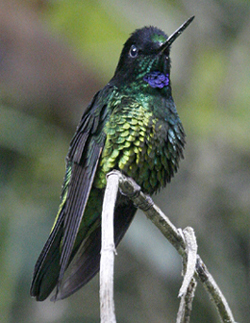
Dusky Starfrontlet
A rare and stunning bird seen very
well near El Jardin.
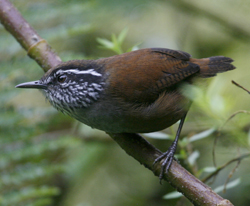
A very showy Munchique Wood-Wren
found by our group and thus confirmed
at Altos Ventanas near El Jardin.
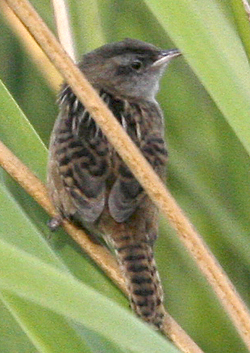
Apolinar’s Marsh Wren
Another speciality that can be easy,
if you know where to find it!
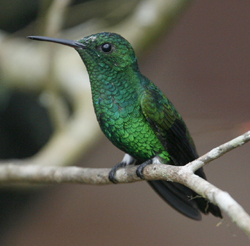
Close views of Steely-vented Hummingbird were obtained in Cali.
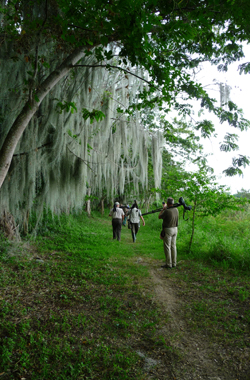
The trail out to the marsh at
Laguna de Sonso.
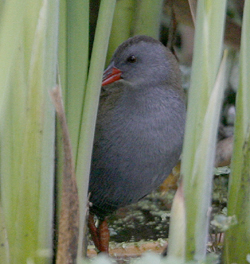
No less than 10 Bogota Rails were seen
well
at our wetland site.
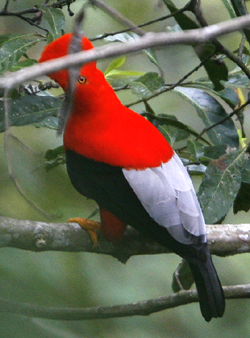
Seen on 4 days this was the best chance
for a photo of a glorious male Andean
Cock-of-the Rock.
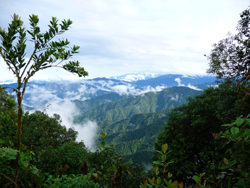
View from Galapagos Road near
El Cairo, a stunning area with
fantastic birding.
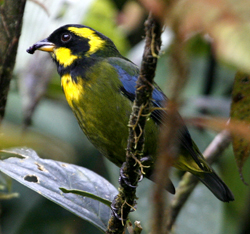
We saw plenty of these stunning
endemic Gold-ringed Tanagers along
Galapagos Road.
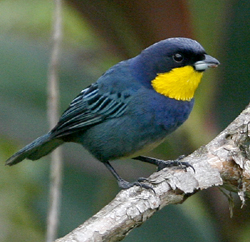
Not an endemic but small groups of
this very smart looking Purplish-mantled Tanager were easily seen on the
Galapagos Road.
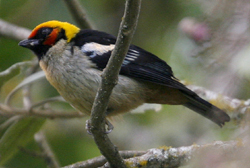
Flame-faced Tanager.
One of so many that showed well
for us on this trip!
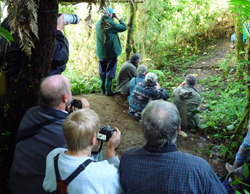
Waiting for Antpittas at Rio Blanco.
What a show!
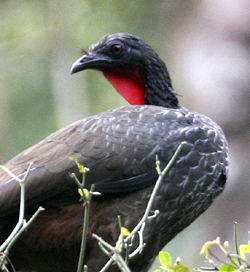
We had superb views of 10 Cauca Guans,
a Colombian endemic that is endangered
and declining because of severely fragmented habitat.
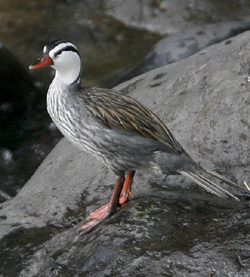
Torrent Ducks are always a favorite
and a pair on a tumbling river on the
way to La Suiza proved no exception.
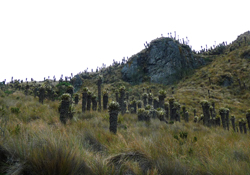
Paramo habitat which was ideal
for
seeing Bearded Helmetcrest
plus a
host of other high
altitude specialities.
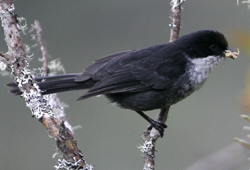
Several Black-backed Bush-Tanagers
showed well up in the paramo.
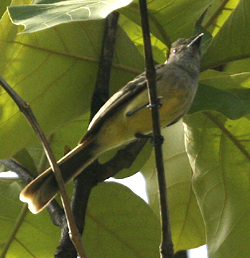
A difficult species to find we enjoyed excellent views of this
Apical Flycatcher near El Cairo.
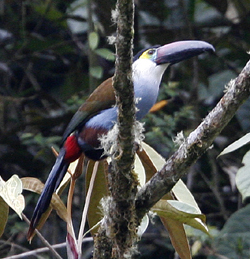
We had some really nice close
views of
this stunning looking
Black-billed
Mountain-Toucan
at Rio Blanco.
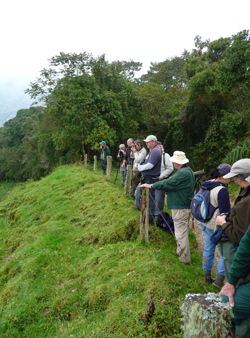
Birding at Rio Blanco.
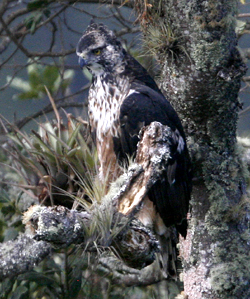
We got close views of this
immature
Black-and-chestnut Eagle
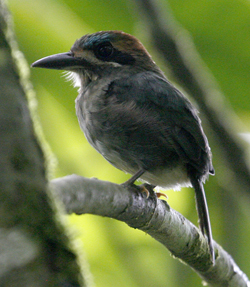
Not many birders see Tody Motmot
in Colombia list but this one eventually
gave itself up nicely.
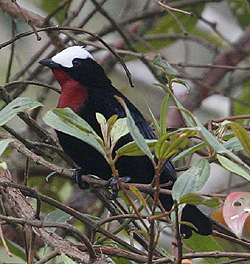
A group of White-capped
Tanagers
were a trip favorite
as they entertained
us along the
bird-filled road at Jardin.
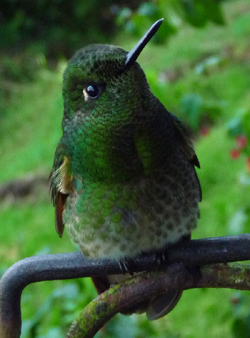
Buff-tailed Coronet was among the
most common hummingbird at the
feeders at Rio Blanco.
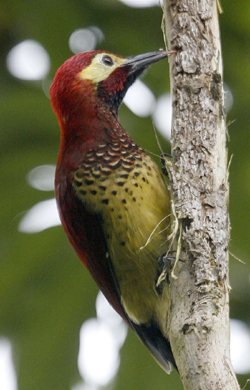
A stunner, this Crimson-mantled Woodpecker was one of two seen
from
just a few feet away
at Rio Blanco.
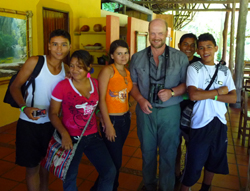
Friendly teenagers at the restaurant
at Rio Claro seemed intrigued by us
and
our interest in Colombia's birds.
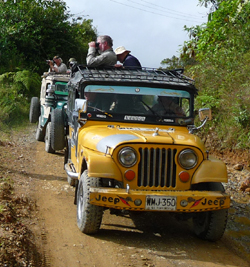
Birding from the Jeeps on
Galapagos Road.
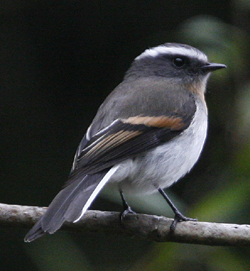
Rufous-breasted Chat Tyrant
seen at Galapagos Road.
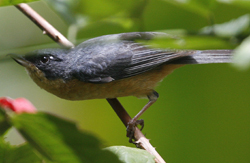
Rusty Flowerpiercer was common
as we got to the lower altitudes
at Los Nevados.
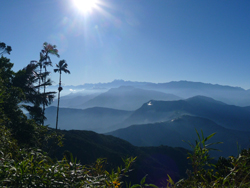
A very special place!
The remote, beautiful and unspoiled wilderness of the Santa Marta Mountains. This is the amazing view from San Lorenzo
above El Dorado lodge at Santa Marta.
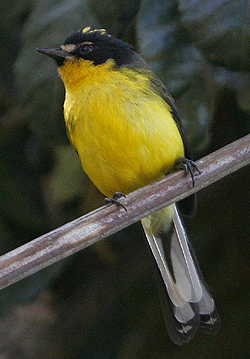
Yellow-crowned Redstart
Another Santa Marta endemic
we saw lots of these
smart looking birds!
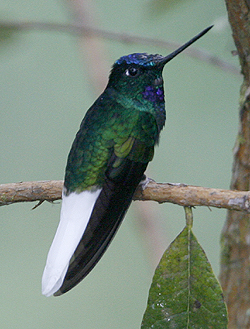
One of the endemic specialities
of the gardens at El Dorado
Lodge was this male
White-tailed Starfrontlet.
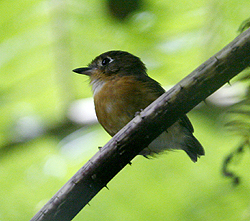
On a stop during our our bumpy journey
up to the lodge in the mountains
we got superb looks at a pair
of showy Rusty-breasted
Antpittas.
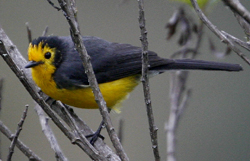
Golden-fronted Redstart
One of many seen while descending
from Los Nevados.
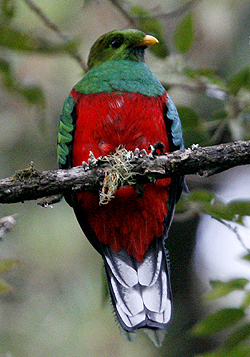
The most restricted and rarest
of all South America's Quetzals this
White-tipped was very showy.
We enticed a Brown-rumped Tapaculo to show itself to most of the group, while a large raptor then drifted past and was seen to land in a large tree. Closer inspection and we were looking at an immature Black-and-chestnut Eagle. A Santa Marta Bush-Tyrant showed very briefly to a few of us and then we found Tennessee Warbler and a couple of White-tailed Starfrontlets, another Santa Marta Bush-Tyrant and we had more amazing flight views of the Santa Marta Parakeets as they took flight from a tree and flew straight at us. More mixed flocks included showy White-lored Warblers and Slate-throated Redstart, fabulous looks at some perched Santa Marta Parakeets in the evening sunlight and our finale to the day was a pair of stunning White-tipped Quetzals which perched close, called and gave wonderful views. One evening we enjoyed superb views of a Mottled Owl, but sadly Santa Marta Screech-Owls were heard but none came close enough to view.
Our final day in the mountains saw us bird the woodland just up from the lodge where we were happy to get very good views of Yellow-legged Thrushes and a very confiding pair of Gray-throated Leaftossers. Walking down from the lodge we encountered Strong-billed Woodcreeper, Golden-breasted Fruiteaters, several Black-hooded Thrushes, a Lined Quail-Dove and after some hard work good looks at Santa Marta Foliage-Gleaner. We stopped off at our Blossomcrown site and were duly rewarded with good views of a male feeding on the flowering shrubs.
Our last two days were spent around the coast and its associated dry scrub. In the wetlands and mangrove we found plenty of Brown Pelicans, Neotropic Cormorants, Magnificent Frigatebirds, Great Blue and Cocoi Heron, Reddish Egrets, Wood Stork, Roseate Spoonbills, a Lesser Black-backed Gull, Caspian, Royal and Sandwich Terns and a real surprise a Forster’s Tern. The latter turning out to be the first record for the whole of South America!
It was however the dry thorn scrub that we were to pay particular attention to as it held several sought after specialties A White-tailed Nightjar sat amongst the leaf litter was a good start, followed by great views of everything including Green-rumped Parrotlet, Brown-throated Parakeets, Black-crested Antshrike, Straight-billed Woodcreeper, Northern White-fringed Antwren, Pale-eyed Pygmy-Tyrants, Pearly-vented Tody-Tyrant, Northern Scrub Flycatcher, Slender-billed Inezia and the superb looking White-whiskered Spinetail. Hummingbirds included Red-billed Emerald and super views of Buffy Hummingbird. Several Russet-throated Puffbirds posed nicely, and further searching revealed Gray Kingbirds, Scrub Greenlet, Prothonotary and Blackpoll Warblers, Trinidad Euphonia, Orinocan Saltator, an elusive Tocuyo Sparrow, Carib Grackles, Pileated Finch, Lesson’s Seedeater and finally after some anxious moments we caught up one of the stars of this area the Chestnut Piculet. It wasn’t a bad area for raptors and apart from a few commoner species we also saw Hook-billed Kite, Common Black Hawk, Harris’s Hawk, Great Black Hawk, Aplomado Falcon and bagsy even got photos of a close Collared Forest-Falcon. Departing this area on our return to Bogota we checked out some coastal mangroves and pools and here we saw many species of shorebird with highlights being hundreds of Black-necked Stilts, eight Wilson’s Plovers, Willet and Short-billed Dowitcher. A male Muscovy Duck sat up in a tree, a few Bare-eyed Pigeons were noted and our target species the Chestnut-winged Chachalaca was seen very well.
Back in Bogota and due to most of us having flights later in the day, we decided to have another morning back in the hills above the city to look for some species we had missed on our very first day. We stopped along the road after spotting a mixed flock much to the amusement of the army stationed in a base across from where we parked. Here we got to grips with Scarlet-bellied Mountain-Tanager, Golden-fronted Redstarts, a Green-tailed Trainbearer and the one bird we really needed to find, the endemic Rufous-browed Conebill. We ended up getting fantastic looks at about seven of these and during the morning we also added Tyrian Metaltail, Glowing and Coppery-bellied Pufflegs, Smoky-brown Woodpecker, Andean Tit-Spinetail, three Pale-naped Brush-Finches, five species of hemispingus including Black-headed,Rufous Wren, Black-chested Mountain-Tanager, a close Plushcap and absolutely incredible views of a Rufous Antpitta. An Andean Guan showed well feeding on top of a small tree, and after a lot of hard searching we eventually found three Silvery-throated Spinetails. We just about cleaned up on everything! Later, we visited the city park where we watched a nice Pied-billed Grebe with chicks, several Spot-flanked Gallinules, plus many American Coots of the distinctive colombiana race, and a lone Masked Duck. Our only Peregrine Falcon of the tour was seen and we got very close views of a hunting White-tailed Kite, while the reed beds ended our tour perfectly with a Bogota Rail, a group of Band-tailed Seedeaters, a Noble Snipe that walked out into the open and stunning looks at a Subtropical Doradito.
The whole tour had been fantastic and even more enjoyable with a wonderful group of people. Many excellent birds were seen, and everyone was assured that Colombia was a safe and superb place to go birding.
Many thanks,
Steve & Gina